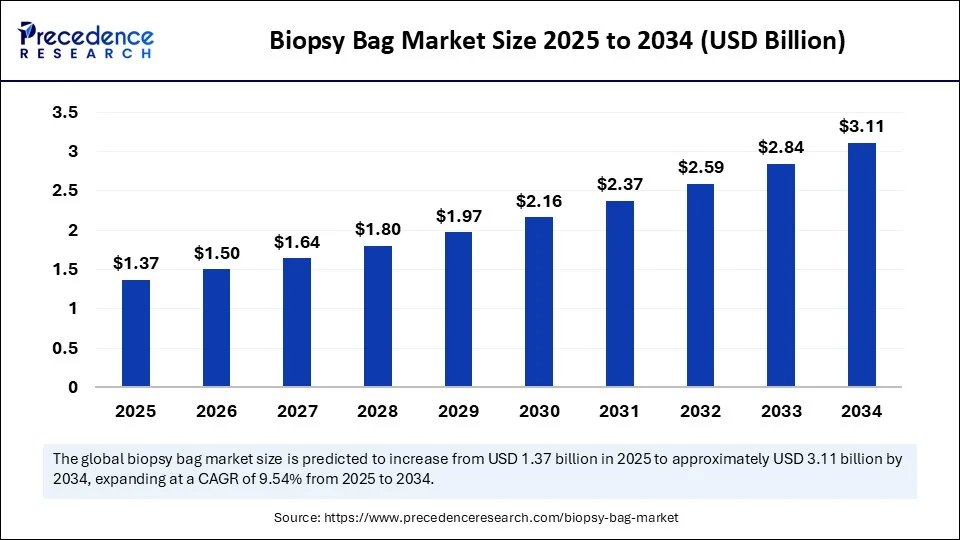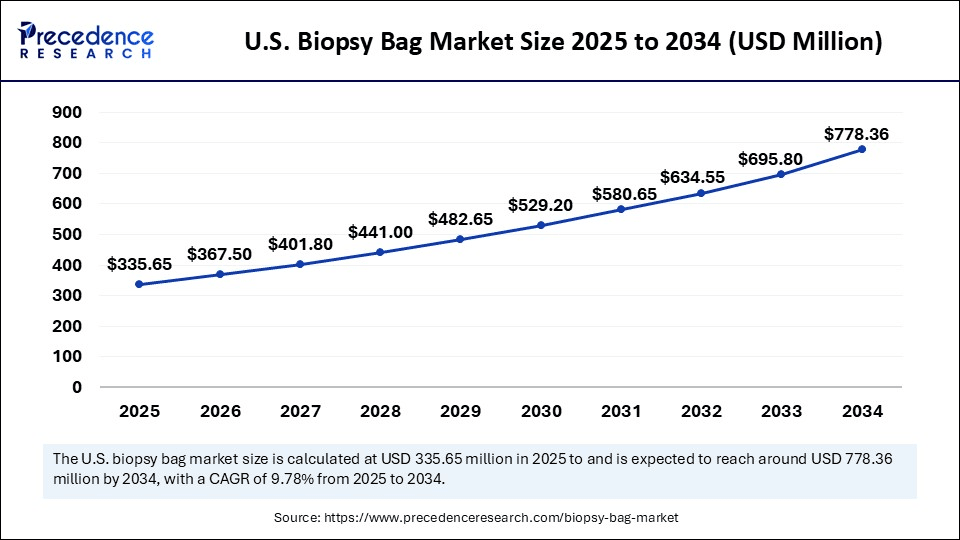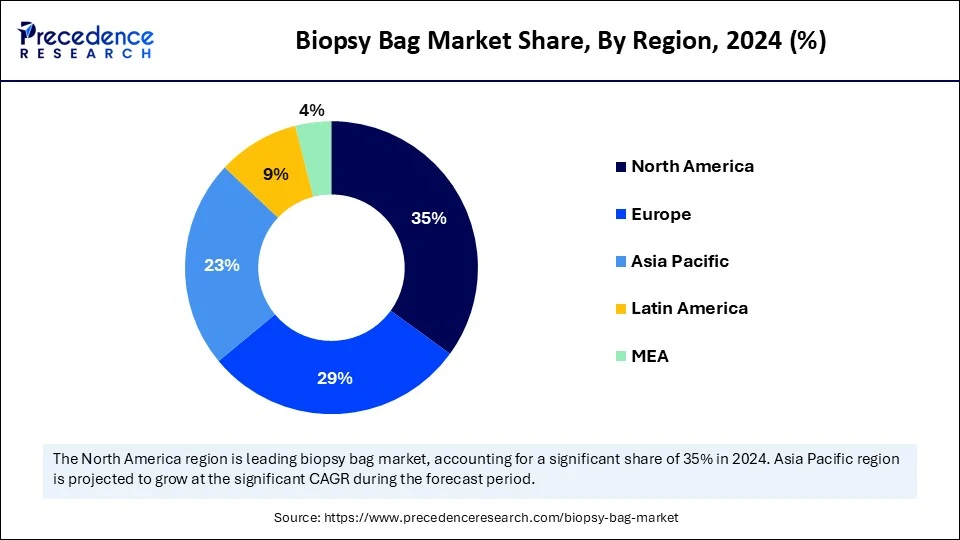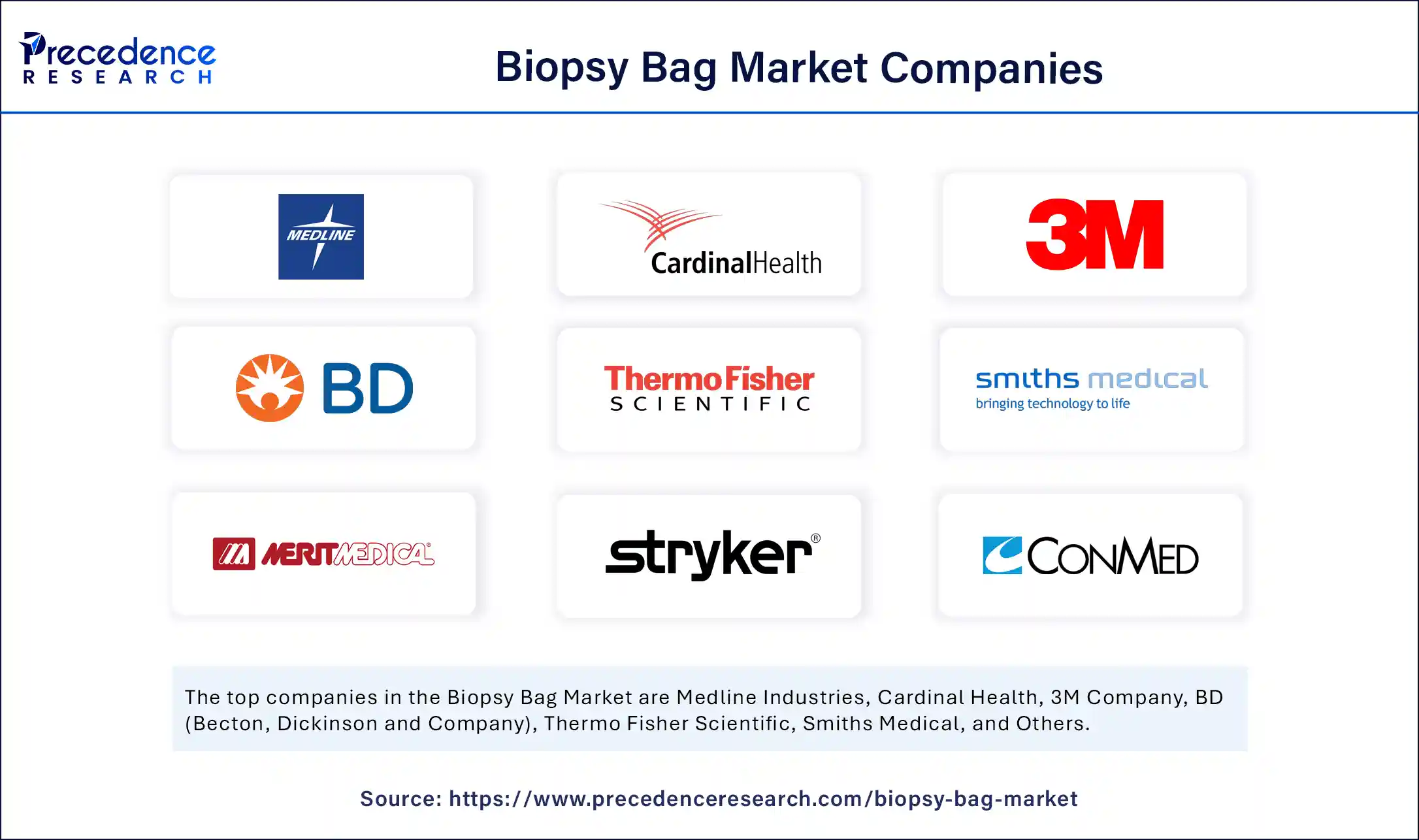What is the Biopsy Bag Market Size?
The global biopsy bag market size is calculated at USD 1.37 billion in 2025 and is predicted to increase from USD 1.50 billion in 2026 to approximately USD 3.11 billion by 2034, expanding at a CAGR of 9.54% from 2025 to 2034. The market is driven by rising cancer prevalence, increasing biopsy procedures, and growing demand for safe and contamination-free specimen handling.

Biopsy Bag MarketKey Takeaways
- In terms of revenue, the global biopsy bag market was valued at USD 1.25 billion in 2024.
- It is projected to reach USD 3.11 billion by 2034.
- The market is expected to grow at a CAGR of 9.54% from 2025 to 2034.
- North America dominated the global biopsy bag market with the largest share of 35% in 2024.
- Asia Pacific is anticipated to witness the fastest growth during the forecasted years.
- By product type, the disposable biopsy bags segment captured the biggest market share of 55% in 2024.
- By product type, the customized biopsy bags segment is anticipated to show considerable growth over the forecast period.
- By material type, the polyethylene segment contributed the highest market share of 50% revenue share in 2024.
- By material type, the nylon segment is anticipated to show considerable growth over the forecast period.
- By closure type, the zip lock segment generated the major market share of 60% in 2024.
- By closure type, the snap lock segment is anticipated to show considerable growth over the forecast period.
- By end use, the hospitals segment accounted for the significant market share of 65% in 2024.
- By end use, the ambulatory surgical centers segment is anticipated to show considerable growth over the forecast period.
- By application, the tumor biopsy segment held the largest market share of 40% in 2024.
- By application, the organ biopsy segment is anticipated to show considerable growth over the forecast period.
How is AI Integration Driving the Biopsy Bag Market?
Artificial Intelligence -assisted imaging and diagnostic solutions allow clinicians to better target the presence of suspicious lesions, thus maximizing the right biopsies and reducing time-consuming and unnecessary tissue samples. This ensures greater precision of diagnosis, greater efficiency, and limited possibilities of sampling errors. Also, digital pathology with AI increases consistency in analyzing biopsy samples and reduces errors due to human participation, particularly because biopsy samples are now analyzed more reliably
Market Overview
The biopsy bag market addresses the world's need, availability, and marketability of specialized containment bags used to safely collect, carry, and store tissue samples acquired during surgical, noninvasive, or diagnostic operations. Such bags are designed to maintain the integrity of specimens and to avoid contamination, leakage, and cross-infection, which is essential to proper pathological analysis. In hospitals, diagnostic laboratories, as well as research and outpatient surgical facilities, they are generally used on all types of tissues, such as soft tissues, organ tissue, and tumor specimens.
Increasing awareness of cancer detection at the early stage and the issue of regular health check-ups also lead to an increased biopsy volume, providing an additional boost to the market. In addition, increased healthcare spending and the growing healthcare infrastructure in developing countries will drive the market growth, as the increased access to superior medical services will be converted into the heightened usage of biopsy bags.
What Factors Are Fueling the Rapid Expansion of the Biopsy Bag Market?
- Increase in cancer prevalence: The number of patients who undergo diagnostic and surgical procedures to ensure early cancer detection or monitoring is on the rise; this means that there is an increasing need to have safe and contamination-free handling of the specimen. Biopsy bags are used when tissue has to be preserved to facilitate good pathology analysis, and this factor drives the market.
- Rising surgery procedures: Biopsy bags are leak-proof, sterile, and allow safe passage of a specimen, hence necessary in the contemporary healthcare environment. The proliferation of this number of procedures certainly leads to the faster spread of the use of biopsy bags worldwide.
- Improvements in material and design: Biopsy bags have improved over the years in terms of efficiency due to ongoing research in terms of materials, sterilization methods, and methods of closure systems. There is a boost in user confidence and the safety of the procedures, and thus, escalated usage in hospitals, labs, and surgery centers..
Market Scope
| Report Coverage | Details |
| Market Size by 2034 | USD 3.11 Billion |
| Market Size in 2025 | USD 1.37 Billion |
| Market Size in 2026 | USD 1.50 Billion |
| Market Growth Rate from 2025 to 2034 | CAGR of 9.54% |
| Dominating Region | North America |
| Fastest Growing Region | Asia Pacific |
| Base Year | 2024 |
| Forecast Period | 2025 to 2034 |
| Segments Covered | Product Type, Material Type, Closure Type, Application, End Use and Region |
| Regions Covered | North America, Europe, Asia-Pacific, Latin America, and Middle East & Africa |
Market Dynamics
Driver
Expansion of diagnostic imaging services
One of the leading growth factors in the biopsy bag market is the growth of diagnostic imaging services all over the world. The rise of technological discoveries in the field of imaging, in different imaging techniques like MRI, CT scans, and ultrasound, has contributed to the detection of tumors and, therefore, to knowing the abnormality earlier than before. This development has enabled an explosion in the number of image-guided biopsies performed, and image-guided biopsies are more accurate and have a decreased invasion level than the conventional models. Developing markets are also driving up such imaging with the provision of imaging facilities due to the increasing healthcare spending and infrastructure building. Investments made by governments and privately owned organizations in the healthcare infrastructure are increasing as new hospitals are being set up, and modern imaging facilities are being made available.
Restraint
Fluctuations in raw material supply
Variation in medical-grade polymers supply is one of the major constraints that could affect the market. The introduction of polymers is usually jointly interrupted by aspects, including the scarcity of raw materials, unlimited trade, geopolitical issues, and instability of prices in the petrochemical market. Such fluctuations in supply have a direct influence on production schedules and cost-driven manufacturing, which will result in pricing and availability in the market. The accessibility to steady providers of raw material sources is less in the case of small manufacturers, especially those existing in developing regions, which makes it challenging to maintain cost competitiveness. Such fluctuations trigger some inconsistencies between manufacturers and end-users, and the volatility of raw material supply can be listed among the most problematic restrains of the biopsy bag market.
Opportunity
Rising demand for personalized medicine and precision diagnostics
The biopsy bag market holds high expansion potential in its wake as the world's healthcare gradually shifts toward personalized medicine and precision diagnostics. Personalized medicine focuses on customizing treatment based on the genetic makeup of a person, lifestyle, and clinical data; thus, it demands accurate and detailed diagnostic insights. The integrity of samples is maintained with contamination-free storage, safe transport due to these bags. Besides, rising cases of cancer and other abnormalities are a stimulus to the global volume of biopsies. Therefore, the transformation to personalized medicine health care results in sustainable market growth.
Product type insights
Why did the disposable biopsy bags segment lead the global biopsy bag market in 2024?
The disposable biopsy bags segment led the market while holding a 55% share in 2024. Single-use consumables have become a priority to single-use consumables in hospitals and diagnostic laboratories to prevent cross-contamination. The benefits of having disposable biopsy bags include convenience, disposability, and cost friendliness, among other areas, where these bags are the best option in routine diagnostic and surgical operations. Medical care systems established tougher standards of hygiene, which are also still reflected in purchasing patterns. Also, regulatory measures that have promoted adherence to the infection control and biosafety standards further boost the intentionality of the disposable variety of bags.
The customized biopsy bags segment is expected to grow at a significant CAGR over the forecast period, with increasing demand for procedure-specific and patient-focused solutions. Customized products are differentiable from the standard types of disposable biopsy bags, as they meet the exclusive needs of various biopsy types, such as tissue size, organ specificity, biopsy type, and compatibility. The increased use of precision diagnostics and personalized medicine is also stimulating the demand for customized biopsy bags, as the healthcare industry is moving towards implementing solutions that support both more specialized testing methodology and technology-advanced processes of pathology. Also, research facilities and specialty clinics are actively searching for customized consumables to enhance accuracy.
Material type insights
Why did the polyethylene segment hold the largest share in the global biopsy bag market in 2024?
The polyethylene segment held a 50% share in the market in 2024. Polyethylene is the most popular to use because of its durability, flexibility, and low prices. It is chemically and moisture resistant, hence biopsy tissues are safe and uncontaminated throughout transportation and storage. The polyethylene is also light and easily handled, thereby making the handling aspect minimal to the hospital and diagnostic centers handling large numbers of biopsy samples. Due to the diversity of polyethylene, the manufacturers are enabled to create biopsy bags in any size and wall thickness to address the different requirements of medical processes.
Polyethylene remains the most extensively utilized material in the manufacture of biopsy bags owing to its combination of very low cost, safety, and performance.
The nylon segment is expected to grow substantially in the biopsy bag market. Nylon is the best alternative in terms of tensile strength over polyethylene and is especially beneficial in handling the smaller or more fragile tissue specimens safely and securely. It is very durable, and this greatly reduces the probability of puncture or tear risks, which are essential in the preservation of the integrity of the specimen, both in transporting and handling. Moreover, nylon is resistant to extreme temperatures and sterilization, and thus it is very appropriate in health settings where there are high infection control criteria. The increasing trend to apply high-tech methods of diagnosis and complicated procedures of biopsies also promotes the rise in the need for materials that deliver better results and consistency. The nylon segment is likely to exhibit robust growth rates, as increased demands for safety, durability, and biosafety compliance in healthcare facilities will stimulate the activity of the segment.
Closure type insights
Why did the zip-lock segment lead the global biopsy bag market in 2024?
The zip lock segment led the market while holding a 60% share in 2024. The zip lock closures are common in healthcare establishments because it is easy to use, re-close, and seal reliably, although, when used together, their ability to establish security for specimens during handling and transportation is ensured. These bags offer a convenient solution to medical personnel, and they require minimal force to close the bag securely, as well as protect the container against leakage and contamination. They can also be easily labeled and specimens identified due to their transparency and re-peelable property, and are ideally suited to hospitals, diagnostic and out-patient surgical units handling high loads of biopsies. Moreover, zip-lock bags are affordable, come in multiple sizes, and are suited to various sterilization methods, which makes them very widely used.
The snap lock segment is expected to grow at a significant CAGR over the forecast period, due to the growing use of adaptable and safe closure systems. Snap lock biopsy bags offer the benefit of extra precautions because they include a tamper-evident airtight seal. This significantly decreases the risk of spillage or contamination or opening of the biopsy bag before the actual patient is tested, and during transportation. Their rigid closure design lends itself particularly well to sensitive, high-value biopsy samples that require additional integrity assurance due to the sensitivity of that particular sample. Increased use of image-guided and complex types of biopsy has further driven the adoption, as there is a need to employ higher closure solutions.
End-use insights
Why did the hospitals segment hold the largest share in the global biopsy bag market in 2024?
The hospitals segment held a 65% share in the market in 2024. The facilities have high infection control and biosafety standards, and thus, a secure and sterile biopsy bag becomes an essential requirement to store specimens, transport, and provide disposal. Advanced pathology labs and qualified medical personnel, which commonly perform complex biopsies, are also available in hospitals, a factor that increases pressure on specimen containment solutions. Furthermore, the current prevalence of cancer across the world has greatly contributed to the fact that biopsy procedures are commonly conducted in hospitals, which further strengthens the market demand for biopsy procedures. The increasing utilization of minimally invasive biopsy procedures at the hospitals will also require constant availability of safe and contamination-proof biopsy bags.
The ambulatory surgical centers segment is expected to grow substantially in the biopsy bag market. ASCs offer an easy, yet affordable alternative to a traditional hospital setting to patients who need minor surgical procedures, such as a biopsy. As the preference toward same-day diagnosis and treatment increases, ASCs are also conducting an increasingly larger volume of image-guided and minimally invasive biopsies, which directly correlates with the demand for sealed, hygienic biopsy bags. Patient safety and efficiency of operations are the most important aspects in such facilities. Moreover, ASCs are growing in both developed markets, through the cost benefits, and in the emerging markets where governments are encouraging low-cost delivery systems of healthcare.
Application insights
Why did the tumor biopsy segment lead the global biopsy bag market in 2024?
The tumor biopsy segment led the market while holding a 40% share in 2024. Tumor biopsies are an irreplaceable practice in diagnosis, staging, and treatment planning of cancer and thus comprise one of the most frequent diagnostic procedures all over the world. The escalating incidences of cancer worldwide have played a direct role in triggering the increased level of cancerous tumors wisdoms which poses a significant need to have secure and contamination-free biopsy bags. Such bags play a key role in preserving the integrity of the tumor tissues, which are frequently examined under genetic, molecular, and histopathological markers to inform precision oncology intervention. Also, the adoption of image-guided biopsy and low-invasivity biopsy techniques has extended the sampling into the tumor tissue supplied by biopsy, further growing the demand.
The organ biopsy segment is expected to grow at a significant CAGR over the forecast period. The rising rate of diseases involving the organ, such as liver cirrhosis, chronic kidney and heart disease, is one of the driving factors of the demand for reliable and safe solutions for the handling of specimens released. Biopsy bags are paramount in storing organ tissue samples safely to maintain sample integrity with respect to the histological and molecular tests. In addition, the segment is growing due to the increasing organ transplantation procedures, which necessitate biopsies to determine rejection or the welfare of the grafts. The introduction of minimally invasive technologies for organ biopsies has also led to an increase in volumes of the procedures, both in hospital and in outpatient care.
Regional Insights
U.S. Biopsy Bag Market Size and Growth 2025 to 2034
The U.S. biopsy bag market size is exhibited at USD 335.65 million in 2025 and is projected to be worth around USD 778.36 million by 2034, growing at a CAGR of 9.78% from 2025 to 2034.

Why did North America lead the global biopsy bag market in 2024?
North America led the global market with the highest market share of 35% in 2024. It has a well-developed healthcare system with the wide use of modern diagnostic tools and numerous biosafety regulations, ensuring a stable demand for biopsy bags. Increases in cancer, kidney disease, and organ transplants are augmenting the use of biopsy procedures, and they are a direct result of commensurate use of the biopsy bags. In addition, high levels of investment in healthcare research and development processes, as well as technological development of the imaging and biopsy technology, are providing healthy market growth environments in the region.
The U.S. has the highest number of biopsy bag markets due to its expansive healthcare facility infrastructure, high spending on healthcare, and early adoption of advanced health technology in healthcare provision. The U.S. is a leader in conducting biopsies to a great extent due to the multiple well-organized cancer screening programs and a high interest in early detection of disease. In addition, the emphasis of the country on personalized medicine, precision diagnostics has increased the need for secure and contamination-free specimen manipulation solutions. The U.S. market is likely to lead the sphere of biopsy bags in the future as it is constantly investing in digital pathology and AI-assisted diagnostics.

Why is Asia Pacific undergoing the fastest growth in the biopsy bag market?
Asia Pacific is estimated to grow at the fastest CAGR during the forecast period, due to the rapid expansion in medical facilities, rising healthcare awareness, and rising investments in the healthcare industry. The governments and healthcare providers are focusing on early detection of diseases by conducting national cancer screening and awareness programs. The diagnostic accuracy is further enhanced by the availability of highly advanced diagnostic technologies such as the image-guided biopsy systems, which are making a significant contribution to the increased volume of biopsies. With the health spending constantly increasing and the stricter implementation of biosafety practices, the Asia Pacific is the emerging regional market with the most rapid growth in demand for biopsy bags.
China is the largest and most influential market for biopsy bags with a blend of highly proactive government programs, a high growth rate of the healthcare infrastructure, and the presence of the largest number of patients across the world. There is a heavy cancer burden in the nation, and especially lung, liver, and colorectal cancer are contributing to biopsy procedure volumes. Further, substantial investments made in diagnostic imaging equipment and the increased use of precision medicine are reinforcing demand in contamination-free and long-lasting biopsy bags.
Value Chain Analysis
- R&D
The technological research and development work to constantly make improvements to the design and the material of the biopsy bag is ongoing to produce more preservation of specimens, improved safety, and compatibility with new technologies in diagnostics. Many companies are preoccupied with sterile, durable, and cost-optimized solutions to fulfill biosafety standards and clinical requirements.
Key Players: Cardinal Health, Inc., Thermo Fisher Scientific, Hologic, Inc., Danaher Corporation, Medline Industries,
- Clinical Trials and Regulatory Approvals:
The safety, effectiveness, and consistency of the new biopsy bag are demonstrated with strict clinical testing, and it guarantees biosafety standards of international standards. Regulatory clearance by organizations such as the FDA and EMA is essential concerning entry, compliance, and credibility, and allows manufacturers to disseminate future adoption into health system environments.
Key Players: the United States Food and Drug Administration and the European Medicines Agency
- Distribution to Hospitals, Pharmacies
The supply chains (e.g., wholesalers, direct selling, and logistics) are utilized to ship the biopsy bags to hospitals, diagnostic laboratories, and pharmacies. Efficient supply chains realize the availability of products, position for infection control measures, and ensure unbroken access to vital consumables in diagnostic and surgical processes.
Key Players: AmerisourceBergen, Cardinal Health, Medline Industries, McKesson Corporation
Biopsy Bag Market Companies

- Medline Industries
- Cardinal Health
- 3M Company
- BD (Becton, Dickinson and Company)
- Thermo Fisher Scientific
- Smiths Medical
- Merit Medical Systems
- Stryker Corporation
- ConMed Corporation
- Cook Medical
- B. Braun Melsungen AG
- Mölnlycke Health Care
- Nipro Corporation
- Terumo Corporation
- Baxter International
- Yuwell-Jiangsu Yuyue Medical Equipment
- Halyard Health
- Huhtamaki Group
- Shanghai Fudan-Zhangjiang Bio-Medical Products
- Shanghai Hongyuan Medical Devices
Recent Developments
- In October 2024, T2 Biosystems signed a multi-year exclusive U.S. distribution agreement with Cardinal Health. The team-up will enable T2 Biosystems to scale its presence in the market and T2 Biosystems to provide more diagnostic solutions to Cardinal Health customers in healthcare facilities in the United States.(Source:https://www.globenewswire.com)
- In September of 2024, Cardinal Health announced the purchase of Integrated Oncology Network (ION) at a cost of about 1.1 billion dollars. Despite healthcare demand increasing, the acquisition boosts the capability of Cardinal Health to tackle the impact of cancer care, diagnostic testing, and integrated oncology networks by augmenting its presence in oncology diagnostics and community healthcare services.(Source: https://newsroom.cardinalhealth.com)
Segments Covered in the Report
By Product Type
- Standard Biopsy Bags
- Disposable Biopsy Bags
- Reusable Biopsy Bags
- Customized Biopsy Bags
- Others
By Material Type
- Polyethylene
- Polypropylene
- Nylon
- PVC
- Other Synthetic Polymers
- Others
By Closure Type
- Zip Lock
- Tie Closure
- Adhesive Seal
- Snap Lock
- Others
By End Use
- Hospitals
- Diagnostic Laboratories
- Research Institutes
- Ambulatory Surgical Centers
- Others
By Application
- Soft Tissue Biopsy
- Organ Biopsy
- Tumor Biopsy
- Bone Biopsy
- Other Tissue Biopsies
By Region
- North America
- Europe
- Asia Pacific
- Latin America
- Middle East and Africa
For inquiries regarding discounts, bulk purchases, or customization requests, please contact us at sales@precedenceresearch.com
Frequently Asked Questions
Ask For Sample
No cookie-cutter, only authentic analysis – take the 1st step to become a Precedence Research client
 sales@precedenceresearch.com
sales@precedenceresearch.com
 +1 804-441-9344
+1 804-441-9344